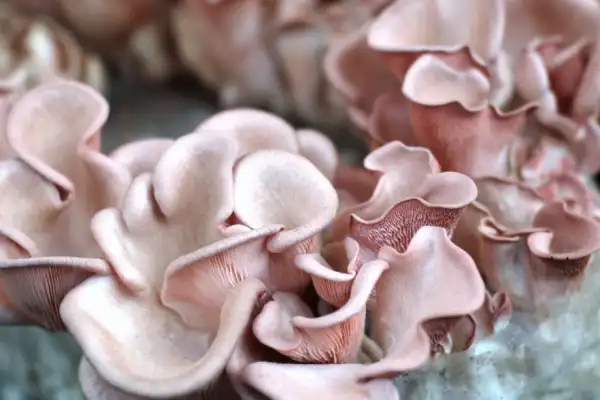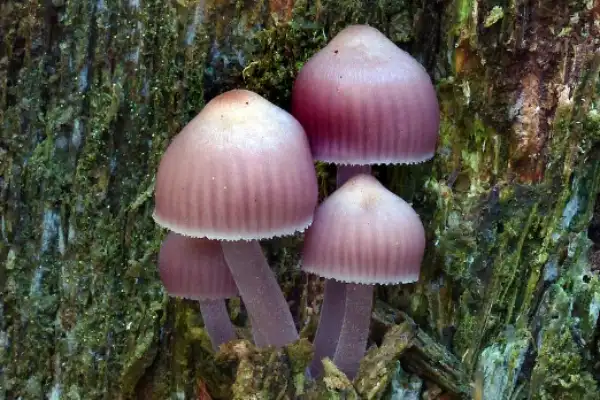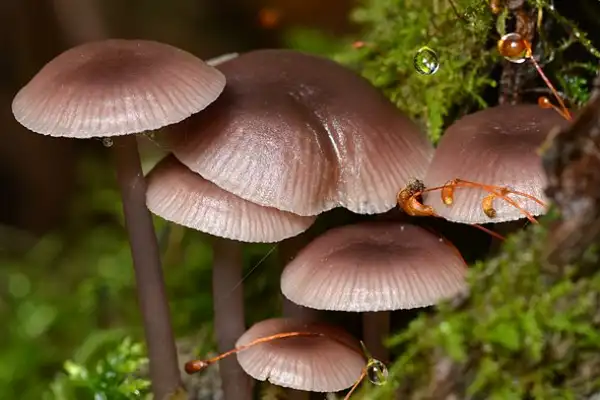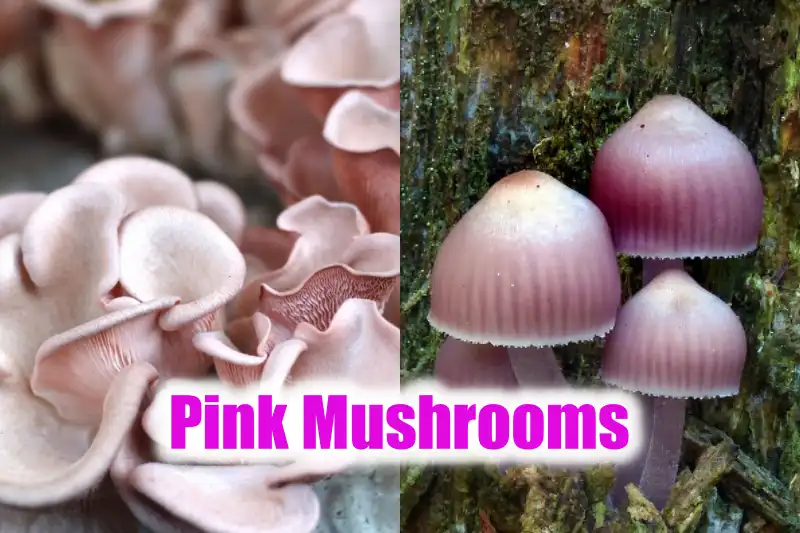Mushrooms, also known as toadstools, are spore-bearing fruiting bodies of fungi. The word mushroom mainly refers to fungi with stems, caps, and gills, like the cultivated button mushrooms.
The word ‘mushroom‘ was derived from the French word mousseron, which means moss. The word mushroom may be edible or inedible; it doesn’t give a clear definition. Toadstool was used in England in the 14th century, which means stool for toads, referring to a poisonous fungus.
Well, the identification of the mushroom might be tricky, as all the fungi need not be umbrella-shaped. We all know that not all mushrooms are edible. So what makes a mushroom toxic? It is all in the types of metabolites the mushroom produces that can be toxic or mind-altering.
Colors usually hold specific meanings in nature, while the reason for the coloration of mushrooms is still mysterious. But the color may depend on the climate. In this article, we are studying mainly pink mushrooms.
Are There Any Pink Mushrooms?
Yes, there are pink mushrooms found in nature. Though pink is rare in the fungal kingdom, there are some fungi, and adding to that, a few of them are edible too. Though only 2% of the fungi kingdom has been identified, it is fascinating that there are so many pink mushrooms. Here are some of the pink mushrooms which are seen in nature.
1. Pink Oyster Mushroom

- Botanical Name: Pleurotus djamor
- Identification: This pink mushroom has a curly cap that is 2–5 cm in diameter. These caps are quite thin, and the stems are very short or nonexistent.
- Geographical Location: Commonly found in Mexican communities.
If a vegetarian wants to taste the umami taste, this pink mushroom is the perfect one. The texture of this pink mushroom is chewy and meaty. This pink mushroom has good health benefits. It is quite nutritious, antioxidant, antibacterial, and supports our immune system.
2. Pink Bonnet

- Botanical Name: Mycena rosella
- Identification: conical or bell-shaped cap and gills adnexed
- Geographical Location: Britain, Ireland, and Brazil
These pink mushrooms are poisonous and should not be collected for food. It belongs to the Mycena, which is bioluminescent and emits weak green light, though the mushroom is pink in color. These pink mushrooms are found in deciduous woodlands and grow on leaf litter.
The gills present on these pink mushrooms are for reproduction while producing spores.
3. Jelly Drops
- Botanical Name: Ascocoryne sarcoides
- Identification: The flesh of this pink mushroom seems rubbery-gelatinous. This mushroom is pinkish-purple in colour.
- Geographical Location: North America, Oceania, and Europe
This pink mushroom has the quality of being a biofuel. Because of its ability to digest cellulose. It grows in clusters on trunks and branches of dead wood. The life cycle of this pink mushroom allows for both asexual and sexual spores.
These mushrooms usually grow on trees that are suffering from Heart rot disease, where the centre of the trunk starts rotting. Also, these jelly-like mushrooms are not recommended for eating.
4. Pink-tipped Coral Mushroom
- Botanical Name: Ramaria botrytis
- Identification: The flesh is thick and white. Length of 7–20 cm and width of 6–30 cm, and is repeatedly branched.
- Geographical Location: Africa, Australia, Chile and, Asia
This pink mushroom resembles a lot like cauliflower and is known by other names like clustered mushroom and coral mushroom. Hence, this pink mushroom is an edible mushroom belonging to the coral fungus species.
Have you ever wondered how a fungus can taste like fruit? This pink mushroom’s stem tastes fruity. This mushroom has chemicals that are useful in biological activities.
5. Lilac Bonnet

- Botanical Name: Mycena pura
- Identification: The cap is convex or bell-shaped and is 2-6 cm in size.
- Geographical Location: Widely in North America
These mushrooms grow in different hues, and pink is one of a kind. This pink mushroom smells like radish and also tastes like it. Though there is no scientific evidence, it is believed that it has hallucinogenic properties. But it definitely has a muscarine chemical in it. Hence, it is not eatable.
6. Brain Mushroom
- Botanical Name: Gyromitra esculenta
- Identification: Has brain-like folds and wrinkles.
- Geographical Identification: Europe, North America, and Asia
This pink mushroom is edible but not eatable. It is highly poisonous and has many symptoms, ranging from nausea, vomiting, and diarrhoea to severe cases like seizures and coma.
This means that vulnerability depends on the individual after consuming this brain-like pink mushroom. Other names for this mushroom include false morels, elephant ears, and turban fungus.
7. Wolf’s milk
- Botanical Name: Lycogala epidendrum
- Identification: Appear as cushion-like blobs and have a diameter of less than 1.5 cm
- Geographical Location: UK and North America
This pink mushroom is named so because pink paste oozes out when the outer layer bursts. These pink mushrooms are found on dead, decaying woods.
This mushroom is not from the fungus family but is from slime mould. And has myths and stories for its name. This pink mushroom can be found fully grown overnight. This pink mushroom is also known as toothpaste slime.
8. Wrinkled Peach Mushroom
- Botanical Name: Rhodotus palmatus
- Identification: thick, gelatinous, and wrinkled, forming ridges.
- Geographical Location: Britain, Ireland, and Scandinavian Countries
This pink mushroom is known as the ‘Most Beautiful British Mushroom’. This mushroom typically grows on rotting British elm trees. Until the Dutch elm disease, this mushroom was very rare, but now it is becoming even rarer. This pink mushroom is considered to be inedible.
Taxonomists have cracked their heads to name this pink mushroom since it has a wide history of taxonomical nomenclature.
9. Rosy rusulla
- Botanical name: Russula rosea
- Identification: flat, bright cinnabar to crimson red with yellow spots.
- Geographical location: North temperate
These pink mushrooms are named after their color, rosy red. Their gills are usually cream in color. They have beautiful fruit bodies. These pink mushrooms do not have a distinct smell but are pleasant-smelling, and their tastes vary from cedarwood-like to bitter.
It is said that some of the rosy rusulla are edible, while others are not, as they can be mistaken for red brittlegill. As already mentioned, since identification of fungi is difficult, they are best not consumed.
10. Wolf Bolete
- Botanical name: Rubinoboletus rubinus
- Identification: Tinted pink in the center and pale towards the margin of the cap.
- Geographical location: Mediterranean areas.
Its name is due to its place of origin. The pink mushroom grows in warm or beech forests. These can grow up to 12cm tall and have a pink hat, which can be 10 cm long. The fascinating thing about this mushroom is that its stem turns blue when touched.
The pink mushroom is poisonous. It must be boiled for a long time in order to be consumed. But since its uses have not been discovered, the mushroom is considered inedible. The pink mushroom smells like acetylene.
11. Pink Wax Cap Mushroom
- Botanical name: Porpolomopsis calyptriformis
- Identification: slightly greasy cap which spits while expanding and turns upward.
- Geographical location: wide spread but localized in Britain.
This pink mushroom has a watery head. Its name means ‘looking like a porpoloma’. They are commonly referred to as having the appearance of pirouetting ballet dancers. The mushroom can grow up to 125mm.
The pink wax grows in acidic soil or natural neutral soil. This beautiful mushroom is now very rare in many countries due to agricultural practices. This mushroom is edible, but due to its disappearance, eating it is not recommended.
12. Mauve Parachute
- Botanical name: Marasmius haematocephalus
- Identification: thin, dark pink and bell-shaped, thin stem.
- Geographical location: sub tropical areas
The pink mushrooms have an amazing ability to rehydrate while they wait for the rainy season, which is why they have the name marasmius, which means drying out in Greek.
The pink mushroom feeds on decomposing matter, and hence it grows on fallen wood or leaves. Some of their family mushrooms are inedible, but as they do not have much flesh, no one would think about eating them.
13. Pinkmottle Woodwax
- Botanical name: Hygrophorus russula
- Identification: hemispherical cap with pink base
- Geographical location: North America and Europe
The name derives from its color. They are usually confused with regular russulas. They grow up to 7cm long and 13cm wide. After rainfall, they are found in fairy rings.
The cap of the pink mushroom is slimy and does not have any taste or smell. Young mushrooms are white and gradually lose color to have pinkish patches. These are edible, but it depends on the source quality.
14. Yellow-gilled Gymnopilus
- Botanical name: Gymnopilus luteofolius
- Identification: purplish to red cap and yellow gills
- Geographical location: North America
The mushroom is famous for its easily identifiable purplish head, which later turns rusty brown. They are about 8cm long and wide. The pink beauty usually occurs in clusters.
These pink mushrooms are not edible, even though they are mildly toxic. Though they look fleshy and attractive, they taste bitter, which is another reason for not consuming them.
15. Rosy Gomphidius
- Botanical name: Gomphidius subroseus
- Identification: slimy pinkish cap and yellow stem
- Geographical location: Europe and North America
The pink mushroom has a pinkish slimy cap that is about 3–6 cm wide and slightly depressed in the center. The gills are pale as they run down to the stem, becoming grayish black. The stem is 3–9 cm long and slimy at the lower level.
These pink gems are edible but are not of high quality. Removing the cuticle on the head may improve the taste.
Are Pink Mushrooms Poisonous?
No, all pink mushrooms are not poisonous. As seen above, many pink mushrooms are consumed. But identification of the edible is really important. Mushroom poisoning is usually due to the misidentification of inedible as edible mushroom species, so proper identification is a must, or else do not consume them.
So what makes some mushrooms inedible? It’s just the type of metabolites produced by them. They produce these to prevent themselves from being eaten. Severe mushroom poisoning can lead to liver failure, kidney failure, and neurologic sequelae.
Conclusion
That was all about the pink mushrooms. Fungi are difficult to identify, so please don’t try any of the mushrooms unless you have made sure that they can be consumed and identified by a professional. I hope this article helped you learn a little about the beautiful pink mushroom.
Also Read:
